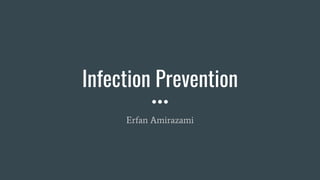
Infection Prevention.pptx
- 2. STANDARD PRECAUTIONS Standard precautions should be followed for the care of all patients even when the presence of an infectious agent is not apparent or is thought to be minimal
- 3. Standard precautions entail: ●Hand hygiene before and after contact with every patient, regardless of whether gloves are also used. ●Use of gloves, gowns, and eye protection in situations in which exposure to blood or body secretions is possible.
- 4. ●Use of respiratory hygiene/cough etiquette by patients or healthcare workers with cough or respiratory secretions; this includes covering the nose and mouth when coughing, disposing of used tissues promptly, and practicing hand hygiene after contact with respiratory secretions.
- 5. Hand Hygiene Hand hygiene refers to handwashing with soap and water or the use of alcohol-based hand disinfection. Hand hygiene is the single most important measure to reduce transmission of microorganisms from one person to another or from one site to another on the same patient. The primary challenge associated with hand hygiene efficacy is laxity of practice, not a paucity of good products
- 6. The SAVE LIVES: Clean Your Hands initiative is part of a major global effort led by the World Health Organization (WHO); it includes "My Five Moments for Hand Hygiene," which define the key moments when healthcare workers should perform hand hygiene: ●Before touching a patient ●Before clean/aseptic procedures ●After body fluid exposure/risk ●After touching a patient ●After touching patient surroundings
- 7. Gloves Gloves should be worn by healthcare workers in situations in which exposure to blood or body secretions is possible; they provide a protective barrier for the healthcare worker as well as the patient.
- 8. Masks Masks should be worn by healthcare workers caring for patients in the following categories: ●Patients with respiratory secretions, to protect healthcare workers from patients' infectious material (such as aerosols containing blood or body fluids).
- 9. ●Patients undergoing sterile procedures (including invasive spinal procedures), to protect patients from respiratory aerosols generated by healthcare personnel performing the procedure. In addition, masks should be worn by patients with respiratory secretions who are coughing if they leave their hospital rooms, to limit spread of infectious secretions to other patients and to healthcare workers.
- 11. ISOLATION PRECAUTIONS Three isolation categories reflect the major modes of pathogen transmission in nosocomial settings: contact, droplet, and airborne spread.
- 12. Contact Precautions Contact precautions are used for the care of patients with selected multidrug-resistant bacteria and various enteric and viral pathogens. Patients who require contact precautions should be in a private room or in a cohort with other patients who have the same indication for contact precautions.
- 13. ● Healthcare workers should perform hand hygiene and wear gloves upon room entry, even if no direct patient contact is anticipated. ● Gowns should be worn even if direct contact with the patient or infective material is not anticipated. ● Upon room exit, gowns and gloves should be removed and hand hygiene should be performed immediately since hands predictably become contaminated during glove removal
- 14. Medical equipment should be dedicated to a single patient when possible in order to avoid transfer of pathogens via fomites. Equipment that is not dedicated to a single patient must be cleaned and disinfected before reuse.
- 15. Type of Precaution Selected patients Contact Colonization of any bodily site with multidrug-resistant bacteria (MRSA, VRE, drug-resistant gram-negative organisms) Enteric infections (Norovirus, Clostridium difficile, Escherichia coli O157:H7) Viral infections (HSV, VZV, RSV, parainfluenza, enterovirus) Scabies Impetigo Noncontained abcesses or decubitus ulcers (especially for Staphylococcus aureus and group A Streptococcus)
- 16. Droplet Precautions Droplets are particles of respiratory secretions ≥5 microns. Droplets remain suspended in the air for limited periods. Transmission is associated with exposure within three to six feet (one to two meters) of the source.
- 17. Droplet precautions are used for the care of patients with suspected or confirmed infections with Neisseria meningitidis, Bordetella pertussis, influenza, parainfluenza, adenovirus, Haemophilus influenzae type b, Mycoplasma pneumoniae, rubella, and other pathogens spread by droplets.
- 18. Respiratory syncytial virus (RSV) may be transmitted by the droplet route but is primarily spread by direct contact with infectious respiratory secretions. Therefore, the most important intervention for prevention of RSV transmission in healthcare settings is adherence to contact precautions (plus standard precautions)
- 19. Healthcare workers caring for patients on droplet precautions should wear a surgical mask when they are within six feet of patients . No special air handling systems or higher level respirator masks are required for the care of patients with known or suspected infection due to organisms capable of droplet transmission. The doors of rooms used to house these patients may remain open (in contrast with airborne precautions).
- 20. Airborne Precautions Airborne droplet nuclei are particles of respiratory secretions <5 microns. Droplet nuclei can remain suspended in the air for extended periods and thus can be a source of inhalational exposure for susceptible individuals.
- 21. Airborne precautions are warranted for the care of patients with suspected or confirmed tuberculosis (TB), measles, varicella, smallpox, and severe acute respiratory syndrome (SARS).
- 22. Patients on airborne isolation precautions should be placed in a private room with negative air pressure that has a minimum of 6 to 12 air changes per hour. Doors to the isolation rooms must remain closed, and all individuals who enter must wear a respirator with a filtering capacity of 95 percent that allows a tight seal over the nose and mouth.